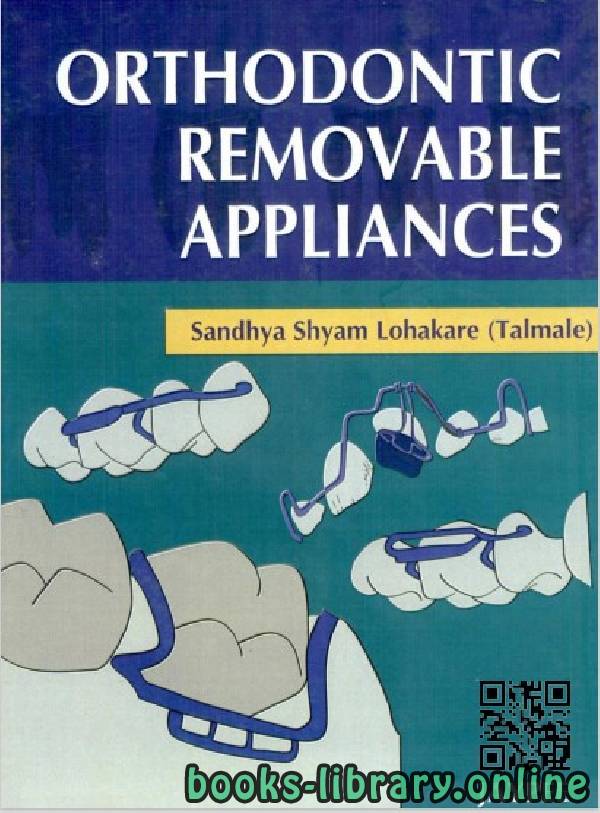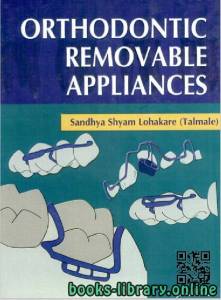📘 ❞ Orthodontic Removable Appliances ❝ كتاب ــ Sandhya Shyam Lohakare اصدار 2008
كتب طب الأسنان - 📖 كتاب ❞ Orthodontic Removable Appliances ❝ ــ Sandhya Shyam Lohakare 📖
█ _ Sandhya Shyam Lohakare 2008 حصريا كتاب ❞ Orthodontic Removable Appliances ❝ 2024 Appliances: Orthodontic Removable Appliances Sandhya (Talmale) MDS (Orthodontia) VSPM Dental College and Research Centre Digdoh, Hingana Nagpur, India JAYPEE BROTHERS MEDICAL PUBLISHERS (P) LTD New Delhi Ahmedabad Bengaluru Chennai Hyderabad Kochi Kolkata Lucknow Mumbai Nagpur Preface Orthodontics is one of the important clinical branches dentistry It starts from prenatal stage continues throughout your life base cosmetic Malaligned teeth give ugly look to face smile does not feel heart warming To correct these crooked teeth, we are using some mechanical means in oral cavity They called as removable appliances Because it used by patient, so considered The other deals with management loss vitality enamel chip off, of bone periodontal tissue for good facial while smiling But orthodontics conserving the whole structure redirection tooth new perfect position Removable major culprit preventive, interceptive corrective These simple manage, economic time saver, i e there less involvement an orthodontist This book includes all retentive parts, active technique wire bending, biomechanical considerations, modification different malalignments I sincerely hope that this will prove useful students practitioners Contents 1 History Review Literature 1 2 4 3 Biomechanics 7 4 Components 11 5 Active 16 6 Passive 49 7 Retentive Component 55 8 Plate Construction Finishing 63 9 Practical Management 65 Summary 67 Bibliography 69 *************** 24 components • Springs – Provide extra length increase range action resiliency Extra can be provided form coil (s), loop (s) or change configuration provide wire 25 component Wire springs Spring design Recommended St round (0 5mm) diameter The must ensure adequate springiness keeping acceptable strength spring guided its exerted only appropriate direction by: Place an undercut slip occlusally during activation Use a guide hold Bond attachment surface engage spring 26 Short labial arch Constructed 0 030 inch 7 OR 8) contact middle 1 3 21 12 Loops should ½ width canine, extend slightly above gingival margin closely adapted where cross occlusal Palatal arms contour palate 27 Clasps Adam’s clasp C (Circumferential clasp) Lingual extension Ball clasp 28 Clasp most designed MB, DB undercuts posterior Advantage, separate has excellent retention 29 Fabrication Arrow heads 2 Bridge Tags 4 parts made mm hard wire 30 Design modifications Long bridge One arrow head Solder HG tube hook he bridge 31 Adjustment clasp 32 Circumferential Useful second molars canines Easier keep out supportive, retainer, but appliance 33 like Adam, extends across embrasure Uses buccal Easy fabricate stiff could extended deep into undercuts 34 Extension works lingual aspect without crossing embrasures mm) Can placed first molar premolar Difficult adjust Break easily May cause irritation if retainers, appliance 35 Acrylic plate vehicle carry Appliance together Anchor tool movement self curing acrylic resin Steps construction (see handouts) 36 Adjunct fixed orthodontic Bite plane horizontal shelf part bite plate, on which touch planes also (i bonded attached palatal arch) 37 prevent treat abnormal orofunctional habits Crib An appliance correction deleterious such deviating tongue digit sucking A crib consists transpalatal [0 036 9 heavier gauge] For appliance, embedded supported via (clasps) soldered two maxillary permanent bands (for appliance) toward anterior forms shaped "fence" meant interfere habit Posterior (lateral) cribs patients unilateral bilateral open 38 Space maintainers replace prematurely lost deciduous teeth 39 retain obtained movement, either appliances 40 Clinical Maxillary more tolerable successful than mandibular ones Because stability baseplate fits better lower During treatment adjustments performed follow: Tightening clasps they become loose Activation screws bows Trimming (as required) 41 Combined functional Growth guidance combined adding three problems:• goal therapy term expansion questionable VS improving Class II success Two point difficult attained 42 Advantages Appliance: More patient ( removed socially sensitive occasions) fabricated lab rather directly patient’s mouth, reducing dentist’s chair Allow types growth carried readily possible كتب طب الأسنان مجاناً PDF اونلاين هو فرع من فروع الطب يختص بدراسة وتشخيص ومعالجة أمراض الفم والوجه والفكين والأسنان والأنسجة المحيطة بها والوقاية منها ويتفرع إلى العديد الاختصاصات يعتبر فنا وعلما أطباء أو جراحو هم المختصون تشخيص ووقاية وعلاج تجويف يساعد طبيب فريق داعم يوفر خدمات مثل استخدام التصوير الشعاعي وغيرها التقنيات لضمان صحيح وتخطيط للعلاج قد يشمل العلاج ملء تجاويف وإزالة أعصاب أثناء علاج الجذور اللثة قلع إذا استلزم الأمر واستبدال المفقودة بأطقم كثيرا ما يستخدم التخدير قبل الذي يسبب الألم يمكن بالذهب الفضة الخزف مزيج تدخل الأنسجة الرخوة للفم ضمن مجال أكثرها شيوعا
Orthodontic
Removable Appliances
Sandhya Shyam Lohakare (Talmale) MDS (Orthodontia)
VSPM Dental College and Research Centre
Digdoh, Hingana
Nagpur, India
JAYPEE BROTHERS MEDICAL PUBLISHERS (P) LTD
New Delhi . Ahmedabad . Bengaluru . Chennai . Hyderabad
Kochi . Kolkata . Lucknow . Mumbai . Nagpur
Preface
Orthodontics is one of the important clinical branches of dentistry. It starts from the prenatal stage and continues
throughout your life. It is the base of cosmetic dentistry.
Malaligned teeth give ugly look to the face and the smile does not feel heart warming. To correct these
crooked teeth, we are using some mechanical means in the oral cavity. They are called as removable appliances.
Because it is used by the patient, so it is considered as removable.
The other branches of dentistry deals with management of loss of vitality of teeth, enamel chip off, loss of
bone and periodontal tissue for good facial look while smiling. But in orthodontics we are conserving the
whole structure with redirection of tooth of new perfect position.
Removable appliances are the major culprit for preventive, and interceptive and corrective orthodontics.
These appliances are simple to manage, economic and time saver, i.e. there is less time involvement of an
orthodontist.
This book includes all retentive parts, active parts, technique of wire bending, biomechanical considerations,
modification for different malalignments.
I sincerely hope that this book will prove useful for students and practitioners.
Contents
1. History and Review of Literature.................................................................................................................... 1
2. Orthodontic Appliances....................................................................................................................................... 4
3. Biomechanics .......................................................................................................................................................... 7
4. Components of Removable Appliances ....................................................................................................... 11
5. Active Appliances ............................................................................................................................................... 16
6. Passive Appliances ............................................................................................................................................. 49
7. Retentive Component of Appliances ............................................................................................................ 55
8. Plate Construction and Finishing................................................................................................................... 63
9. Practical Management ........................................................................................................................................ 65
Summary ................................................................................................................................................................. 67
Bibliography ............................................................................................................................................................. 69
24. Active components • Springs – Provide extra length of wire to increase range of action and resiliency – Extra length can be provided in the form of coil (s), loop (s) or change configuration to provide extra length of the wire
25. Active component • Wire springs – Spring design • Recommended wire is St. St. round wire (0.5mm) in diameter • The design must ensure adequate springiness and range while keeping acceptable strength • The spring must be guided so that its action is exerted only in the appropriate direction by: – Place the spring in an undercut of the tooth so that it does not slip occlusally during activation – Use a guide to hold the spring in its position during activation – Bond an attachment to the tooth surface to engage the spring
26. Active component • Short labial arch – Constructed from 0.030 inch (0.7 OR 0.8) round St. St. wire – It must contact the middle 1/3 of the labial surface of the teeth 21|12 – Loops should be ½ width of the canine, should extend slightly above the gingival margin – Wire must be closely adapted where it cross the occlusal surface – Palatal retentive arms must be adapted to the contour of the palate.
27. Retentive components • Clasps – Adam’s clasp – C-clasp (Circumferential clasp) – Lingual extension clasp – Ball clasp
28. Adam’s Clasp • The most useful clasp in removable appliances. • It is designed to engage the MB, DB undercuts of posterior teeth. • Advantage, it does not separate teeth and has excellent retention.
29. Fabrication of Adam’s Clasp • Components of Adam’s Clasp • 1- Arrow heads • 2- Bridge • 3- Tags • 4- Retentive parts • It is made of 0.7 mm diameter hard St. St. round wire
30. Adam’s Clasp • Design modifications Long bridge One arrow head Solder a HG tube to the bridge Solder hook to he bridge
31. Adjustment of Adam’s clasp
32. Retentive component • Circumferential clasp – Useful for second molars and canines – Easier to keep it out from occlusal contact – It is only supportive, not as retentive as Adam’s clasp – It can be adequate for a retainer, but not for an active appliance
33. Retentive component • Ball Clasp – – – – It like Adam, extends across the embrasure Uses buccal undercuts for retention Easy to fabricate It is stiff that could not be extended deep into the undercuts
34. Retentive component • Lingual Extension Clasp – It works only from the lingual aspect without crossing the occlusal surface or embrasures – Short loop of (0.4 mm) wire – Can be placed in the first molar second premolar lingual embrasure – Difficult to adjust – Break easily – May cause tissue irritation – Can separate teeth if active – Can be used for retainers, – not for active appliance
35. Acrylic base plate • It is used as a vehicle to carry all Removable Appliance components together. • It is the Anchor tool for tooth movement. • Use self-curing acrylic resin. • Steps in construction (see handouts).
36. Adjunct to fixed orthodontic appliances • Bite plane The horizontal shelf-like part of a bite plate, on which the teeth touch. Bite planes also can be used in a fixed design (i.e. bonded to the teeth, or attached to a palatal arch).
37. To prevent or treat abnormal orofunctional habits Crib An interceptive appliance used for correction of deleterious habits such as a deviating tongue position and/or digit-sucking. A crib consists of a transpalatal [0.036-inch (0.9-mm) or heavier gauge] wire. For removable appliance, the wire is embedded in acrylic base plate supported via retentive means (clasps) or soldered on two maxillary first permanent molar bands (for the fixed appliance). The wire extends toward the anterior palate where it forms a crib-shaped "fence" meant to interfere with the habit. Posterior (lateral) tongue cribs can be used as part of removable appliances in patients with unilateral or bilateral posterior open bite.
38. Space maintainers • To replace prematurely lost deciduous teeth
39. To retain the obtained tooth movement, either by removable or fixed orthodontic appliances
40. Clinical Adjustment • Maxillary removable appliances are more tolerable and successful than the mandibular ones. Because the maxillary removable appliance can provide more stability as the baseplate fits better than lower removable appliances. • During the treatment the adjustments can be performed as follow: • 1- Tightening of clasps as they become loose • 2- Activation of the spring/screws /bows • 3- Trimming of the baseplate (as required)
41. Combined functional and active plate treatment • Growth guidance can be combined with active tooth movement by adding springs or screws with three problems:• Active tooth movement is not the goal of functional appliance therapy. • Long-term stability of arch expansion is questionable VS improving Class II open-bite or deep-bite treatment success. • Two point contact is difficult to be attained using removable appliance for tooth movement.
42. Advantages of Removable Appliance: • More acceptable to the patient ( can be removed on socially sensitive occasions). - They are fabricated in the lab rather than directly in the patient’s mouth, reducing the dentist’s chair time. - Allow some types of growth guidance treatment to be carried out more readily than is possible with fixed appliances.
#4K
0 مشاهدة هذا اليوم#25K
21 مشاهدة هذا الشهر#15K
14K إجمالي المشاهدات
-
🎁 كن أول كاتب اقتباس في هذه الصفحة واحصل على هديّة 15 من النقاط فوراً 🎁



